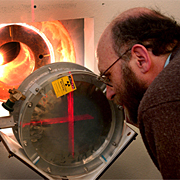- Number 327 |
- December 20, 2010
Los Alamos Neutron Science Center gets capacity boost

Steve Wender of the Los Alamos
Neutron Science Center at Los
Alamos National Laboratory
examines the fission ion chamber
used to measure the number of
neutrons that pass through it to
circuits and other electronic
devices that undergo testing for
potential failure due to cosmic ray
bombardment. The LANSCE facility
routinely hosts a steady stream of
scientists working on critical
research related to LANL's core
mission as well as numerous
industrial users. Consequently,
LANL is planning to increase user
capacity with an upgrade scheduled
for completion in the summer of 2011.
In early 2011, LANSCE-one of the nation's highest intensity linear proton accelerators-will begin upgrades that will effectively double the facility's capacity for experiments and tests on electronic devices by Laboratory, industrial, and academic users. The Los Alamos Neutron Science Center facility has been used for more than a decade by a virtual Who's Who of the semiconductor industry to simulate the potential failures posed by cosmic-ray-induced neutrons upon miniature electronic devices, such as chips that help control aircraft or complex integrated circuits in automobiles. The facility can simulate the effects of hundreds or thousands of years of cosmic-ray-induced neutrons in a single hour. This same capability also aids scientists in understanding how components of nuclear weapons age.
The National Nuclear Security Administration's Los Alamos Site Office and Los Alamos National Security, LLC, the contractor that operates Los Alamos National Laboratory, have agreed to allocate money LANS could have earned from its prime contract fee to upgrade the facility for projects ensuring the reliability of semiconductor chips.
"The Los Alamos Neutron Science Center has consistently shown its value to the nation," said LANL Director Michael Anastasio, president of LANS, LLC. "We are extremely pleased to be able to reinvest in a key LANL facility to ensure continuing scientific excellence and national service."
Knowing how integrated circuitry will perform is important. When cosmic rays from space strike Earth's upper atmosphere, they unleash a shower of neutrons. While the radioactive dose from these showers is relatively harmless to human health, each neutron can interact with integrated circuits to produce charged particles that can potentially disrupt normal operation of devices and the data that is stored within them.
At the end of this year's LANSCE beam cycle, construction will begin on a 4,000-square-foot building that will house additional experimental capacity.
This additional capacity will allow the semiconductor companies to not only have more beam time, but also allow them to better coordinate beam tests with their production schedules. The upgrade should cost about $2 million. The newly upgraded facility is expected to be operational by July 2011.[James E. Rickman, 505.665.9203,
jamesr@lanl.gov]
